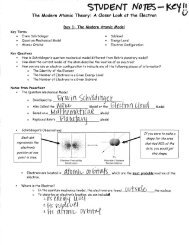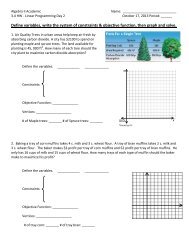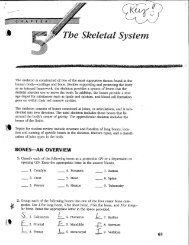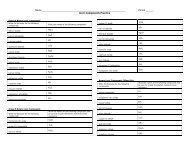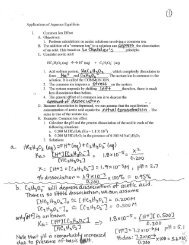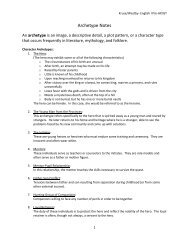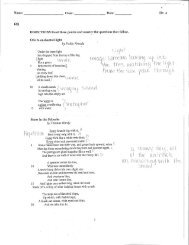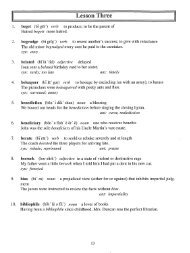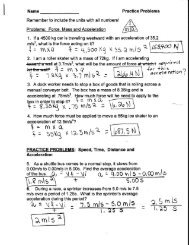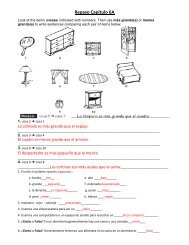Alien Periodic Table Activity.pdf
Alien Periodic Table Activity.pdf
Alien Periodic Table Activity.pdf
Create successful ePaper yourself
Turn your PDF publications into a flip-book with our unique Google optimized e-Paper software.
¢<br />
The <strong>Alien</strong> <strong>Periodic</strong> <strong>Table</strong> Lab<br />
Earth's scientists have announced that they have made radio contact with intelligent life on a distant<br />
'--')lanet. One of this alien planet's languages has been translated, and scientific information has begun to<br />
• be exchanged. This planet is composed of the same elements as Earth. However, the inhabitants of the<br />
:.: .,lanet have different names and symbols for them. Since the alien scientists do not know the names of<br />
our elements, they have radioed the following data on the known properties of these elements.<br />
Strangely, and luckily, there are no transition or inner transition elements on the alien planet. This<br />
means that their <strong>Periodic</strong> <strong>Table</strong> consists of only representative elements. An alphabetical list of all the<br />
symbols is given at the end of the CLUES section. You may wish to mark off each of these elements as<br />
you find its correct place on the <strong>Periodic</strong> <strong>Table</strong>.<br />
Purpose: To place each of the alien elements in the correct position on our <strong>Periodic</strong> <strong>Table</strong> based on<br />
information about the chemical and physical properties of each of these elements.<br />
ment:. pencil (with a BIG eraser)<br />
blank, abbreviated <strong>Periodic</strong> <strong>Table</strong> (last page of lab)<br />
your copy of the <strong>Periodic</strong> <strong>Table</strong><br />
Clues:<br />
The following sets of elements are in the same GROUP:<br />
Kt, Ap<br />
Ub, Ur, Pf<br />
T, Hk, Hi, An By, Ch, Q<br />
Ss, Fx, Vd<br />
M, Pi<br />
;r, Wo, Vn, L, J<br />
A, R, Nu, El<br />
he following elements are in the same PERIOD: Oh, Ur, An, Gr, Bo<br />
I. Tr has an atomic number three times that of M.<br />
2. Oh is the LEAST electronegative metal represented on this <strong>Periodic</strong> <strong>Table</strong>.<br />
3. El has 6 valence electrons.<br />
4. Q is an alkali metal.<br />
5. The element Ub has ONE pair of electrons as well as ONE single electron in its 3rd energy level<br />
6. By is smaller than Ch.<br />
7. E has its highest-energy electron (which is also its outermost) designated as 2p1.<br />
8. The outer electrons of Vu do not experience as much shielding as those of Kt.<br />
9. L has every electron in its second principal quantum number completely paired, and the 2nd principal quantum number is the<br />
highest energy electron it has<br />
10. Kt is a liquid at room temperature.<br />
11. J is a noble gas.<br />
::ii:.:.':2. E is the SMALLEST atom in its group.-<br />
< •<br />
13. The identifying square for Dk is 6p5.<br />
$. Pf's atomic number is the same as the number of days in the month of August.<br />
15. Ap has one LESS energy level of electrons than Vu does.
16. Bo has every electron in its outer energy level paired and therefore does not combine to form compounds under ordinary<br />
conditions.<br />
17. The largest atom in the 5th period is Cn.<br />
!8. The oxidation number (charge) for Bt is -1.<br />
,9. Vd has 5 electrons in its outer orbit.<br />
20. X is a colorless, odorless, flammable gas which was used to fill the Hindenberg.<br />
21. Vn has an atomic number ONE greater than X.<br />
22. D has 2 electrons in the 4s sublevel and no p electrons in this energy level.<br />
23. Ss is a metalloid.<br />
24. Vu is a halogen.<br />
25. Yz is an alkaline earth metal.<br />
26. R has an atomic mass TWICE that of El.<br />
27. Yz has greater electronegativity than M.<br />
28. The +3 ion of Oz has the same electron configuration as that of Krypton.<br />
29. Ur is the only element in the 6th period with a predicted oxidation number of +3.<br />
30. The atomic radius of element Bu is LARGER than element Ss.<br />
31. Atoms of Q have greater radius than those of Ch.<br />
32. Fx and El are in the same period.<br />
/ ....<br />
"3. The electrons of T are distributed over 4 energy levels.<br />
34. The atomic radius of element A is the largest in its column.<br />
35. Element Bu is a metalloid and contains 3 single electrons in its"p" sublevel of the 5th orbit.<br />
36. Element Gr is the only METAL in its column.<br />
37. Element Fp's highest energy electrons are the four electrons in the 5p sublevel.<br />
38. The element Bo has the maximum number of electrons possible in its outer most s and p.<br />
39. The Wo atom contains 54 electrons.<br />
40. More shielding occurs in To than in Pi.<br />
41. The oxidation number of Z is +4.<br />
42. The +1 ion of By contains 2 electrons only.<br />
43. The Pi+2 ion has the electronic configuration of krypton.<br />
44. Hi is a 3rd period metalloid with a predicted +4 or -4 oxidation number.<br />
45. Tlÿe element Z is a metal (not a metalloid).<br />
46. Ap is the most electronegative element.<br />
47. The element To is an alkaline earth metal.
Name: Date: Period:<br />
The <strong>Alien</strong> <strong>Periodic</strong> <strong>Table</strong> Lab<br />
List of alien symbols in alphabetical order:<br />
A, An, Ap, Bo, Bt, Bu, By, Ch, Cn, D, Dk, E, El, Fp, Fx, Gr, Hi, Hk, J, Kt, L, M, Nu, Oh, Oz, Pf, Pi, Q, R,<br />
Ss, T, To, Tr, Ub, Ur, Vd, Vn, Vu, Wo, X, Yz, Z<br />
1<br />
3 4<br />
5<br />
7<br />
10<br />
11 12<br />
13<br />
14<br />
15<br />
16<br />
17<br />
18<br />
19 20<br />
31<br />
32<br />
33<br />
34<br />
35<br />
36<br />
37 38<br />
TRANSITION<br />
METALS<br />
49<br />
5O<br />
51<br />
52<br />
53<br />
54<br />
55 56<br />
81<br />
82<br />
83<br />
84<br />
85<br />
86



